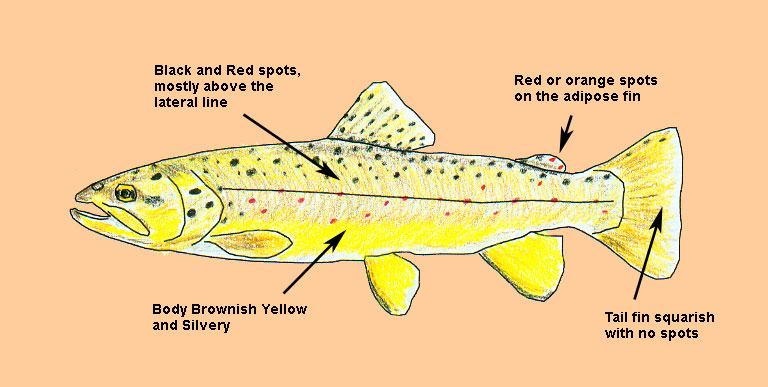|
The Brown trout (Salmo trutta),
originally from Europe, North Africa, the Middle East, and parts of Asia, were
introduced into California in 1893. Since that time, brown trout have been distributed throughout
the state. Brown trout are found in a high percentage of the waters with suitable trout habitat in
California due to their popularity and the resulting extensive stocking during the past century.
Brown trout have adapted well to California waters and their ability to compete with other kinds of
trout has contributed to their widespread distribution. Many of the waters in the Wild Trout Program,
such as Hot Creek, East Walker River, Fall River, Hat Creek, and the Owens River support healthy
brown trout populations. Cherished by many, the brown trout is a challenging adversary for
California  wild trout anglers. These wily gamefish find, occupy, and defend the prime cover and
feeding spots in a stream and often live to advanced age and grow to trophy size. Often, Brown Trout
share many of the same streams as Rainbows. Browns will often dominate the streams if the water
consists of plenty of cover with undercut banks. Rainbows will often dominate if the stream has defined
channels and a medium to fast current. Only when the streams have a complexity of habitat desirable to both, will they coexist.
Browns also have better "dim light" eyesight than most other trout.
Browns will spawn in the Fall when water temperatures drop from 50 degrees to 45 degrees. Often, they will
migrate from Reservoirs into the tributary streams for a period of two-three weeks. The eggs develop over
the Winter and hatch in the Spring. The California State Record is 26 Lbs. 8 oz wild trout anglers. These wily gamefish find, occupy, and defend the prime cover and
feeding spots in a stream and often live to advanced age and grow to trophy size. Often, Brown Trout
share many of the same streams as Rainbows. Browns will often dominate the streams if the water
consists of plenty of cover with undercut banks. Rainbows will often dominate if the stream has defined
channels and a medium to fast current. Only when the streams have a complexity of habitat desirable to both, will they coexist.
Browns also have better "dim light" eyesight than most other trout.
Browns will spawn in the Fall when water temperatures drop from 50 degrees to 45 degrees. Often, they will
migrate from Reservoirs into the tributary streams for a period of two-three weeks. The eggs develop over
the Winter and hatch in the Spring. The California State Record is 26 Lbs. 8 oz
Characteristics:
The brown trout can range from 10-30 inches as an adult. It has a brownish-yellow body but this can be
highly variable. Colorations can range from a deep golden yellow to a silvery gray with hints of greenish
blue. It is the only trout with red or orange spots on the adipose fin, which is just in front
of the tail. Black rounded spots exist above the lateral line and the tail fin is squarish with no spots.
|


